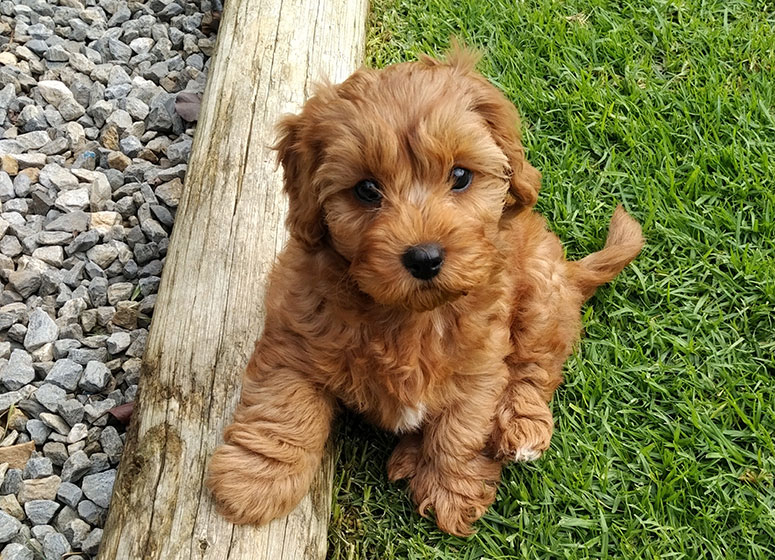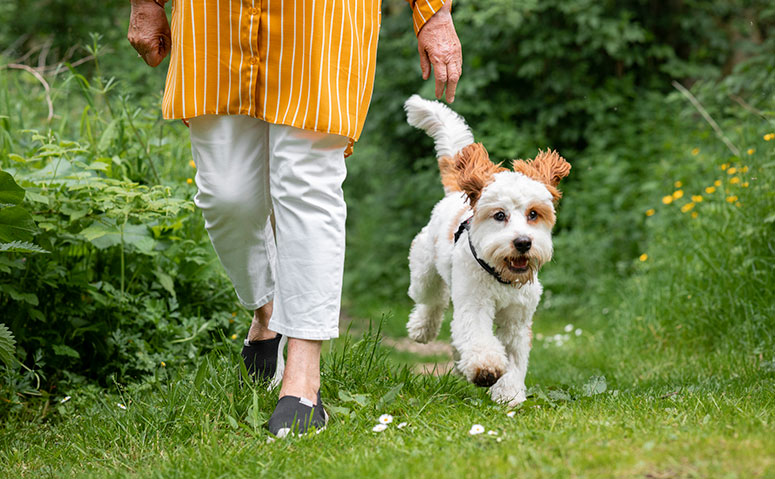Table of Contents
Introduction to Cavapoos
The cavapoo is not a purebred dog but a mix between a Cavalier King Charles spaniel and a poodle. Therefore, the cavapoo is not a breed that is officially recognized by the American Kennel Club. These are playful and curious small dogs, sometimes called cavadoodles and cavoodles. They are considered a designer mixed breed and have inherited some of the best traits of their parent breeds.
Cavapoos are very cute and make wonderful family pets. They do well in apartments and homes with more than one dog. If you’re looking for a friendly and fun pup that’s affectionate and easygoing, a cavapoo might just be the perfect addition to your household.
Size of Cavapoos
Cavapoos are small dogs that weigh between nine and 25 pounds when fully grown. They grow to be between nine and 14 inches tall as adults. A cavapoo puppy reaches its adult size around one year, yet most of the dog’s weight is gained by the time it is just six months old. There are only very small size differences between male and female cavapoos.
Here’s how big you can expect your cavapoo to get as he grows up.
| Weight Chart | 3 months | 6 months | 9 months | 12 months |
| Average Male and Female Cavapoos | 4 lbs. | 9 lbs. | 13 lbs. | 18 lbs. |
Characteristics of Cavapoos
Cavapoos are playful, cuddly, and low-allergen dogs that are good for first-time pet owners. They are easy to train and have a low prey drive, so they aren’t likely to chase animals. However, they require a lot of grooming and are prone to certain health issues.
Families with children and elderly adults often bring cavapoos into their homes because of their pleasant temperament and size. They are fairly adaptable dogs but need plenty of activity and mental stimulation to stay healthy and happy.
As you get to know a cavapoo’s personality, here’s what you can expect based on his or her breed characteristics.
| Breed Characteristic | Level (High, Medium, Low) |
| Affectionate with People | High |
| Good with Kids | High |
| Good with Pets | High |
| Need for Exercise | Medium |
| Energy Level | Medium |
| Intelligence Level | High |
| Able to Be Trained | High |
| Amount of Barking | Low |
| Amount of Shedding | Low |
Something else to know about cavapoos is that they can get separation anxiety if they are left alone for long periods of time or if they are not socialized from an early age.
These pups are easy to train and athletic, which means they often excel in obedience and agility competitions. Since cavapoos are so friendly with everyone they meet, they don’t make great watch dogs and are not likely to bark much, even at strangers.
History of Cavapoos
The history of the cavapoo dates back to at least the 1990s when breeders in Australia mixed Cavalier King Charles spaniels and poodles. However, some records indicate that the first cavapoos may have been bred in Australia as early as the 1950s.
Breeders chose to make this cross to get the intelligence of a poodle along with the outgoing and calm nature of a Cavalier King Charles spaniel. They also wanted to create a low-allergy dog suitable for people suffering from fur and dander sensitivities. Demand for cavapoos has increased since they were first introduced, and the breed is now very prevalent in the U.S.
Cavapoo Standard Information
Since cavapoos are not a purebred dog, the American Kennel Club does not provide breed standard information for this type of dog. However, there are certain physical traits that cavapoos tend to share because of their parent breeds. Additionally, cavapoos are recognized by other dog groups, such as the American Canine Hybrid Club, the Designer Dogs Kennel Club, Dog Registry of America, Inc., International Designer Canine Registry, and Designer Breed Registry.
With regard to appearance, cavapoos have round, brown eyes that are soft and deep set above a small and short snout with a black button nose. These dogs have long, floppy ears and tufts of fur around the mouth that look a bit like a mustache.
Cavapoos have smooth and wavy curls throughout their coat and come in various color combinations. Their fur can be shades of gray, black, brown, red, tan, white, and beige. It is possible for a cavapoo’s coat to change color sometime between birth and full maturity. The coat can be a solid color or a mixture of two or even three colors.
The final size of a cavapoo depends on whether one of its parents was a miniature poodle or a toy poodle. Some cavapoos look more like their spaniel parent, while others have more of a poodle-like look. Either way, these dogs are absolutely adorable!
Caring for Cavapoos
Cavapoos, like all dogs, require loving care to keep them healthy, strong, and thriving in their environments. Caring for a cavapoo is much like caring for any other small breed of dog, but it still requires plenty of time, effort, and dedication from the pet parents.
Here are some general tips for taking the best care of a cavapoo.
Best Living Environments:
- Good in apartments or houses with yards
- Great for urban life
- Homes with children, although very small children should be supervised
- Homes with other pets
- Senior citizen companions
Type of Exercise:
- Hiking with people
- Swimming in water
- Games of fetch in a fenced yard
- Walks around the neighborhood
- Dog parks with other dogs
- Only moderate, not intense, exercise needed
Mental Enrichment:
- Don’t leave alone very long to prevent separation anxiety
- Agility and obedience exercises for stimulation
- Playtime with children and other dogs
- Toys for indoor playtime
Training Strategies:
- Very trainable using positive reinforcement
- Teach to get along with other dogs
- Start training sessions as soon as a puppy is vaccinated
Grooming Tips:
- Very low shedding
- Brush two times per week
- Professional grooming every six weeks
Common Health Problems of Cavapoos
Cavapoos are relatively healthy dogs that have an average lifespan of 12 to 15 years. They have inherited some of the health conditions of their parent breeds, which you’ll want to be mindful of when you bring a cavapoo into your home.
Yearly vet checkups can help detect issues early so you can choose the best treatment options. Pet insurance from Healthy Paws can help make those vet bills more affordable so that you can prioritize your cavapoo’s health without having to worry about finances.
Some of the most common health issues that arise with cavapoos include the following:
- Progressive retinal atrophy that can lead to blindless
- Congenital heart disease, especially mitral valve disease
- Luxating patellas (kneecap disorder)
- Atopy (skin allergies)
- Dental disease
- Syringomyelia/Chiari-like malformation (fluid build-up in the spinal cord)
- Glaucoma
- Epilepsy
Diet and Nutrition for Cavapoos
Since there is such a significant size range for cavapoos, the food your dog needs will largely depend on how much the pup grows. Cavapoos generally need between a half cup and 1.5 cups of food per day, based on their size and activity level. It is very possible for a cavapoo to become overweight with just a few too many extra treats each day. Check with your veterinarian about the most appropriate portion sizes to feed your cavapoo and stick to a regular feeding schedule in the morning and evening.
Where to Adopt or Purchase Cavapoos
Since cavapoos are a designer mixed breed of dog, many people assume they must be purchased from a breeder. However, cavapoos have been around for a few decades now, so you can also find them at shelters and adopt them from rescue groups.
If you are interested in this type of dog, you might start your adoption search with rescue groups for the parent breeds. A couple of examples are Cavalier Rescue USA and the Poodle Club of America Rescue Foundation.
However, reputable breeders can ensure that your new cavapoo puppy is a true cavapoo and not a mix of other dogs in addition to the Cavalier King Charles spaniel and the poodle. Avoid puppy mills that offer very discounted prices on cavapoos by sacrificing the dogs’ health and care. Also, avoid breeders who will not let you meet the puppy’s parents or provide health background information on the parents. Knowing the types of issues that affect the parents can help you be proactive about your own cavapoo puppy’s health.
Related Breeds
Cavapoos are a unique type of dog because of their lineage, but there are other types of dogs that are similar to the cavapoo that you might enjoy getting to know as well. Poodles have been mixed with many different types of dogs because of this breed’s desirable characteristics. Therefore, you can find many different poodle mixes available from breeders and at rescue shelters.
Here are some similar breeds to the cavapoo to learn more about:
- Yorkipoo
- Cockapoo
- Maltipoo
- Schnoodle
- Cavachon
Pet Insurance for Cavapoos
Mixed breed dogs, such as cavapoos, are often thought to be healthier than purebred dogs because of the combination of traits they get from the parent breeds. However, cavapoos still commonly suffer from injuries and illnesses that need to be treated by a vet. Healthy Paws offers cavapoo pet health insurance to cover accidents, illnesses, cancer, emergency care, genetic conditions, and alternative treatments, such as chiropractic care and acupuncture.
We know how much you love your cavapoo and want him or her to enjoy many wonderful years together. Contact us today for a free quote or to learn more about how pet health insurance works.












